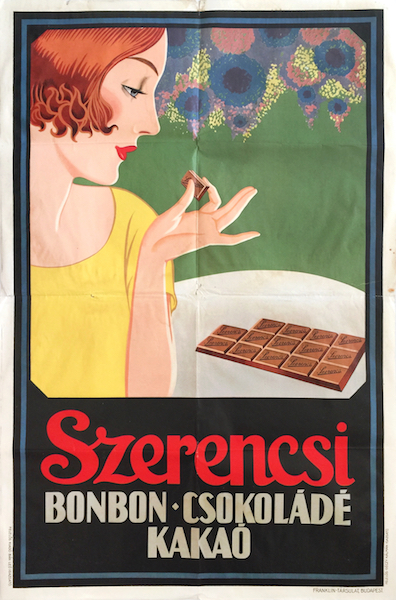
Description:
Gorgeous Art Deco commercial poster from the interwar period. It advertised fancy products of the time: Szerencsi bonbons - chocolate - cocoa. The designer of the poster is unknown.
The Szerencsi chocolate brand has long traditions in chocolate-producing in Hungary. After the World War I there was a fortunate situation in the field of confectionery industry as the competition of Austrian and Czech chocolate companies ended for Hungary. Some companies, which could survive until then, joined their forces and they established the Szerencsi Cocoa and Chocolate Factory in 1921 which started to produce in 1923. In the beginning the factory was producing only one product, simple baking chocolate, but when it had success, the company developed a milk chocolate in 1927 with the name Szerencsi MILK, which is known today as Boci. In 1928 they came out with the well known cocoa powder which had the famous packaging design with a white cat figure. In the 1930s they started to offer candies, bonbons, milk caramel and other desserts, too. Until the World War II the company had the biggest factory in the confectionery industry of Hungary.
The design depicts an elegant female figure sideways as she is holding one piece of Szerencsi chocolate in one hand. She wears a light yellow dress; she has a pale complexion and a sophisticated make-up with a soft blushing, a strong red lipstick and light eye shading. The thin eyebrow is also remarkable. These characteristics, together with the bob haircut, evoke the revolutionary fashion trends of the Art Deco era. As modernity was reflected by lifestyle and world views, garcon silhouettes, glamorous dresses and graceful accessories appeared in fashion. The appearance was completed by a bit puppet-like makeup and the typical bob hairdo which existed in numerous versions. What the female figure is wearing here is a centre-part “flapper” bob haircut precisely.
A white plate can be seen to the right of the figure with the rest of the chocolate bar. The one piece, which is in the hand of the figure, is missing from the row. The pastel green background shows a beautiful flower ornament above. The script of the poster is placed at the bottom of the design, and it appears in red and white typographic design in a black panel.
The poster was probably created between 1924 and 1934. Its graphical character also reflects the visual culture of the era as the design adapts to the style of Art Deco. Although today one could associate Art Deco with the Jazz Age, old automobiles and the world of The Great Gatsby, original posters of the period are also excitingly authentic cultural products / relics of the culture.
The style originally received its name from the Decorative Arts Exposition of Paris in 1925, and it became an important style in international poster art all over the world during the interwar period. Art Deco pieces were modern and traditional all at once with a pinch of exoticism. No surprise, they were highly popular, especially in Europe and America. The most famous representative was A. M. Cassandre in France. The style was also one of the main tendencies in Hungarian poster art during the interwar period, inspiring artists like József Bottlik, Tibor Réz-Diamant or Ernő József Deutsch.
Properly to the Art Deco style, the design has a decoratively stylized character in total. The whole composition is constructed carefully in sense of line, shape and colour. The figure is portrayed with thin lines and soft shapes, and the gentle shades are employed together with tender transitions. The whole figure is highly elegant, even the gaze and hand pose are graceful. The delicate character is made more interesting with an extra touch of playfulness by the little waves of the hair. The beauty of the geometrical shape of the chocolate bar is highlighted, which reveals the way Art Deco was attracted by the industrial design of the era. The portrayal of the flowers gives dynamics for the design, and evokes of the impressionist painting art of the previous century with the pointillist technique.
The pastel colours are in a perfect harmony with each other (the olive green of the background, the bright yellow of the dress and the vivid mixture of purple, blue and yellow of the flowers). The brown shades of the figure’s hair and makeup are in symmetry with the colour of the dark chocolate, while the red of the lipstick appears similarly at the bottom, in the name of the brand. It is depicted in the original typographic design which the chocolate company used those times. The script of ‘bonbons, chocolate and cocoa’ is in white, similarly to the plate in the background, which can give a bit of rest to the eye. The whole composition can be seen in a black frame which, in one hand, is connected to the black panel at the bottom; on the other hand, it creates a perfect balance for the design.
Whoever created the design, they did a great job. From every point of view, the poster reflects gentle elegance and represents it as the atmosphere of consuming the chocolate delicacies of Szerencsi. The advertisement surely had success, supposedly in the upper social classes that it targeted with the exclusive character, which was also typical of Art Deco designs. The reason was that the bourgeoisie and the so-called gentry were those who could enjoy these privileges, as chocolate products were still quite expensive to afford during the period.
Taking everything into account, this work is a highly attractive piece of art; in addition, it is a precious reminiscence of the Art Deco culture as well.
Anita Pásztor
(Sources of information:
hvg.hu
glamourdaze.com)











